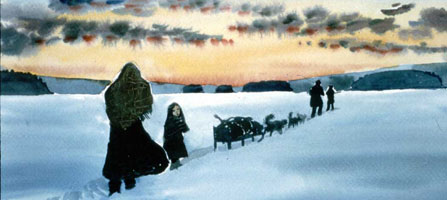|

NPS / Winter Crossing courtesy of Carl Gawboy
Contact: Tim Cochrane, 218-475-0123 Contact: Phyllis Green, 906-487-7149 Grand Portage National Monument Grand Portage Band of Lake Superior Chippewa February 26, 2014 Contacts: Isle Royale Ma’iingan (Wolf) Tells a Grand Portage Story In a winter the likes of what most contemporary Midwesterners have only heard of in the recollections of elders, a lone wolf’s journey reminds us of how the people and animals of Gichi Onigamiing (Grand Portage) have always been connected to Minong (Isle Royale). “Isabelle,” apparently cast out by the other wolves on the Island, set out in late January. She traveled over a newly formed ice bridge on Lake Superior, from Isle Royale National Park to Grand Portage, Minnesota. She was guided on her journey by her instincts including a keen sense of sight and smell. The ice bridge Isabelle used was created by a now unusual combination of very cold temperatures, calm winds, mild surface lake currents, and relatively steady air pressure. The path Isabelle took over the newly formed ice bridge followed a historic route, used for centuries by any and all travelling between Grand Portage and Isle Royale over ice or open water; by foot, dogsled, or boat. Not long ago, during a hot and dry summer, Grand Portage men traveled this same route to fight the 1948 forest fire on Isle Royale. There were few park rangers at the relatively new park and Grand Portage men were experienced fire fighters and many already knew Minong. They returned to their homes months before any wolves were known to have made the crossing to Isle Royale. Even the name “Isabelle” is ironic for Grand Portage residents, many of whom have French Canadian names. Isabelle was at one time, a named heard among the Ojibwe living at Gichi Onigamiing. Ojibwe families have traveled this route to Isle Royale for more than 200 years to hunt, gather, and later work for commercial fisheries, copper mines and resorts. The earliest written record of human travel between Grand Portage and Isle Royale is by John Tanner (an adopted white man) traveling in a birch bark canoe with an Ojibwe family to Isle Royale in 1794. While there they hunted caribou, otter, beaver and fished for sturgeon. In years past, it was commonplace to cross the ice from Isle Royale to Canada or Grand Portage by dog team. The fourteen-mile journey over the ice bridge would have taken a four-dog team approximately three to four hours by toboggan. Usually, one person took the lead, making a trail, three to five dogs completed the team, and another person in back controlled the load. A wolf could travel the same route in less than half the time. Wolves on the mainland might have watched as the grieving parents of their 12 year-old daughter, named Josephte Aiakodjiwang, was hauled on a dog sled over an ice bridge from Isle Royale to the mainland more than 150 years ago, on February 21, 1857. These same wolves were also likely wary of the Ojibwe mail carriers making the trek to the island by dog team to deliver regularly scheduled mail to copper miners on the island in the 1870s. Many of those mail carriers were Grand Portage Band members. But the ice did not always hold. Three Cornish-American miners and sometime mail carriers left the Island for Grand Portage but never made it to the mainland. The connection between Grand Portage and Isle Royale is ancient, in great part, because of the relative geographic closeness. Grand Portage is the closest point on the United States mainland to Isle Royale. But even long before the creation of the United States, in fact, thousands of years before, aboriginal people brought copper from Isle Royale through Grand Portage. Isle Royale copper is sprinkled in some archeological sites following the Grand Portage trail and border lakes to the west. And further yet in time, recent research has discovered that wenda ginebig (common garter snakes) on Isle Royale are most closely related to snakes in the Grand Portage area and yet they have been separated populations for more than 9,000 years. Isabelle’s journey ended in Grand Portage where she died of unknown causes. She was discovered by a local girl, Alyssa Spry, age 11, on February 8, 2014 as she played near the frozen beach on Grand Portage Bay. Alyssa’s father, Chad Spry, explained to his daughter that the collar that identified Isabelle was actually a tracking device used on wolves to learn more about how they live. The Grand Portage Band also studies moose and wolves on the reservation to learn about their health, numbers, and issues facing their survival. Isabelle’s story resonates with the people of Grand Portage. Her last journey on a cold winter’s twilight reaffirms their connection to Minong, a pivotal part of Grand Portage Ojibwe culture and lifeways. Less ice on the Big Lake makes the immigration of wolves to the Island less likely. As there is less ice on the lake, seemingly, the Island has moved further away from Grand Portage. But extreme climatic events like this winter and its ephemeral ice bridge are not a thing of the past. And unlike the fragile ice bridge of today, the Grand Portage Band and the National Park Service are working together to create stronger links. Through the Grand Portage Band’s generosity, they have returned the ma’iingan named Isabelle to the National Park Service so that we can learn more about how she lived, what she ate, and perhaps how she died. Generosity is a traditional Ojibwe value. Scientific knowledge and those that are following Isabelle’s story are beneficiaries of Ojibwe values to share. And through common cause Isle Royale National Park and the Grand Portage Band of the Lake Superior Chippewa Tribe are routinely working together to understand significant plants and animals such as wolves or prevent the further spread of aquatic invasive species in Lake Superior. |
Last updated: March 18, 2020
